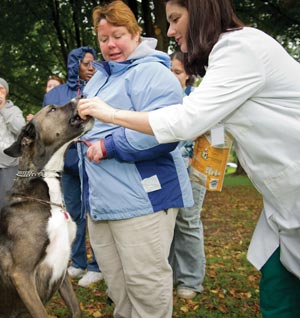Report details methods for helping low-income pet owners
A new report by the Humane Society of the United States highlights the need for accessible and affordable pet care in underserved communities.
The document, "Pets for Life—A New Community Understanding," released Jan. 27, states that increasing access and removing cost barriers to animal care and veterinary services for pet owners in blighted areas will improve community animal health and reduce shelter overpopulation.

The report presents data gathered from events organized by the HSUS Pets for Life program, which uses various strategies to extend the reach of animal services, resources, and information to help people resolve obstacles to keeping pets in the family. It is one of many national programs that targets low-income pet owners (see JAVMA, Oct. 1, 2009).
According to a 2010 survey by the American Pet Products Association, 62 percent of U.S. households own a pet, which it calculates represents 72.9 million homes. At the same time, 46.2 million people were living in poverty in 2010, according to the U.S. Census Bureau.
In difficult economic times, families can have trouble providing for the health and welfare of pets, as demonstrated in the report. The key findings include the following:
- Fifty-three percent of owners of sexually intact pets included in the survey had never seen a veterinarian before.
- Eighty-seven percent of attendees at Pets for Life events had never contacted their local animal control or animal shelter organization for any reason.
- Meeting people in the neighborhoods where they live and marketing services strategically, using canvassing and community organizing techniques, is much more effective than traditional advertising in reaching owners of sexually intact pets in underserved communities.
- Confirming spay or neuter appointments a day or two beforehand substantially increased the likelihood of owners following through.
The data used in the report were taken from service records and surveys conducted at 16 outreach events in 11 markets held since March 2010 and represent close to 4,000 people and their 5,377 pets.
"The data in this report is evidence that there are large segments of our population that are not counted in animal welfare or veterinary statistics, and which are not being serviced by the animal welfare and veterinary fields," according to the report. "To successfully address this current gap in services, animal welfare service providers must recognize and understand the value in building trusting relationships with the human caregivers of companion animals. Meeting people where they are, approaching them without judgment, and understanding their circumstances is critical to the efforts of animal welfare service providers in creating real and lasting change in their communities."